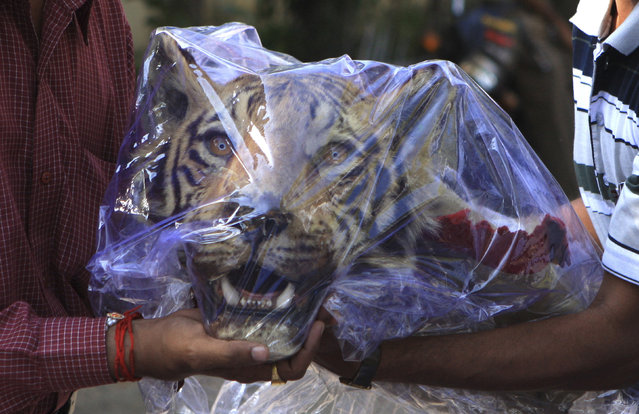The Supreme Court asks Centre to start Project Leopard. After our tiger tales, we can only hold our breath

Supreme Court wants to conserve the spots along the lines of the stripes. But how secure are the tigers in the first place?
Exactly a week ago, the Supreme Court asked the Centre to launch efforts to save leopards on the lines of Project Tiger.
This came along the lines of a public interest litigation filed by animal rights activist Anupam Tripathi.
In his litigation, Tripathi says that India has lost 886 leopards in the past two years. A bench of Justices Madan B Lokur, AM Khanwilkar, and R Subhash Reddy sought a response from the Centre on whether it was open to launching a "Project Leopard" along the lines of Project Tiger. Project Tiger is a considered a highly successful conservation programme for the national animal.
Or is it?
Despite the structured and intense efforts towards conserving the national animal, India recorded 98 tiger deaths and 17 cases of seized bones, skins, and claws, resulting in an estimated total loss of 115 tigers in 2017. In 2018, 85 tiger deaths have been recorded so far with 25 cases of poaching and seizures of parts — as of date.

Between 2014 and 2016, there was a 63 percent rise in cases of poaching and confiscation of tiger parts in the country. According to a response in Rajya Sabha by former Union environment minister late Anil Dave on April 10, 2017, there were 19 cases of tiger poaching and seizure in 2014, but the figure increased to 31 in 2016. These do not include cases that are still under scrutiny — 14 in 2014, that rose by 200 percent to 42 in 2016.
According to the standard operating procedure issued by the National Tiger Conservation Authority (NTCA) — the country’s apex body overseeing tiger conservation — every tiger death has to be treated as a case of poaching unless proven otherwise. "A detailed forensic examination is necessary when the cause of death seems suspicious. But unfortunately there are very few laboratories in India," says Shekhar Kumar Niraj, head of TRAFFIC, the wildlife trade monitoring network. Over 3,000 court cases pertaining to tiger poaching are pending today because of delay in laboratory examinations, adds Niraj. As many as two-thirds of the tiger deaths in India remain uninvestigated.
Before you blame fiscal deficiency, read this: The NTCA allocated more than Rs 15,000 crore to 21 states in 2015-16. The amount does not include the money spent on other wildlife conservation schemes to save the tiger.
While the numbers increased from 1411 tigers in 2006 to 2226 in 2014, we need to ask ourselves where we are in terms of conserving their habitat, managing man-animal conflict and ensuring the poachers and other offenders are brought to book? With an abysmal conviction rate of 10 percent of the registered cases, poaching continues to be a high-reward, low-risk proposition.
And if the tigers were treated with such nonchalance, how can one expect a successful Project Leopard programme when as many as six leopards are poached for every tiger that is killed? India lost 260 leopards in the first six months of 2018 — a 205 percent more than the number of tiger deaths recorded in over 10 months this year. 90 of these leopards fell prey to the poachers. 22 were killed by villagers in human-leopard conflicts. But then, how many cases have been investigated and the offenders booked?

The government's disdain is apparent as there is no authoritative figure for estimating leopards' population decline. The last leopard census was conducted in 2015 — and even that did not cover states like Haryana, Himachal Pradesh, Gujarat and Jammu, and Kashmir where incidents of leopard sighting are random.
However skewed the numbers might be if we considered the 2015 estimates as an official number, the count in the wild was 7910 leopards — down by about 82 percent in the past two decades from the 1998 estimates of 45000 animals. Under such circumstances, one is left with very little hope of investigating leopard deaths — which are killed in far larger numbers owing to habitations closer to human areas (unlike the tigers) and simply them not being as charismatic in the conservation arena as compared to their striped counterparts.
"Unlike tigers, leopards are not a conservation priority for the government. They are treated like a nuisance. If we are not careful, there will be only two or three left before we know it,” says Belinda Wright, who heads the Wildlife Protection Society of India (WPSI), a well-regarded NGO working in the area of conservation.
With our spots becoming more vulnerable than our stripes, it is time the Supreme Court mandated an independent Project Leopard programme with more stringent laws that is not along the lines of the Project Tiger. The tiger's future in India is clearly not burning bright.

